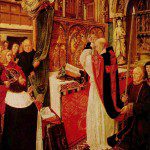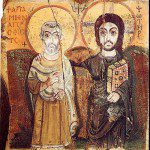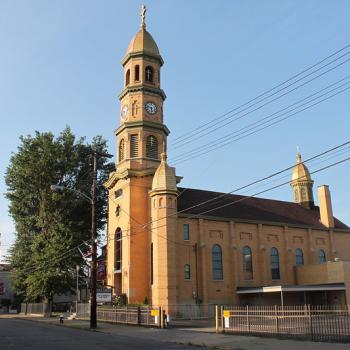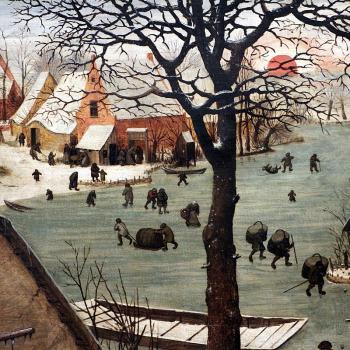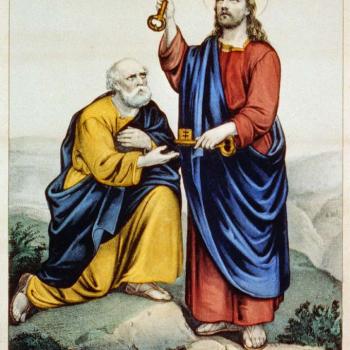July 16th marked the 962nd anniversary of the so-called “Great Schism.” As someone deeply invested in the reunion of the Catholic and Orthodox Churches, I am happy to announce the publication of this three-part essay exploring its background, causes, and unexpected quirks. It is by a friend of mine, whose work is the fruit of a summer research project, which was then presented at a conference a couple of years ago. Enjoy!
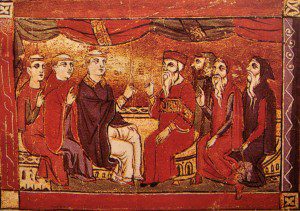
Among the supposed “great dates” of history, one stands out strongly to those interested in the history of Christianity; the Great Schism between East and West, centered squarely on our charts in 1054 AD. If you have ever come across references to this Schism in popular works, the press, or even in many textbooks, your idea of it probably bears some resemblance to this: before 1054, the Christian Church was completely united, with no divisions. Then, in or around 1054, a conflict arose between Western and Eastern Christians over the phrase filioque, which the Pope had added to the Nicene Creed. As a result, the Pope and Patriarch of Constantinople excommunicated each other, and the united Church of the first millennium was split into two bodies, the Catholic Church and the Orthodox Church. This story, tragic as it may be, holds little interest for most American Christians, who are generally more interested in the Protestant Reformation of five hundred years later than in what seems to be an opaque squabble over theological language.
Yet for many Catholics and Eastern Orthodox, this is, to say the least, a much bigger deal. The question of what happened, who was in the right, and who was at fault a thousand years ago is thought by many to be a matter of great importance, with powerful implications for their own faith and self-understanding. Thus, those who, like me, are driven by curiosity to learn more about the Great Schism enter an entirely different phase of understanding, one defined by a thousand years of polemics and myth-making. The accounts to be found in this world are, of course, far more detailed than the popular picture given above; yet even a cursory glance will show how far they diverge from each other, not only in terms of interpretation, but even in terms of the events themselves. What they all share in common is this: by the end of the first millennium, East and West had already diverged significantly in both culture and theology. Then, in 1054 AD, Pope Leo IX sent a delegation (led by one Cardinal Humbert) to the Byzantine capital of Constantinople in order to negotiate with the Patriarch of Constantinople, Michael Cerularius, who had expressed disagreement with some Western practices. The two parties quarreled, and in the end, Humbert excommunicated Cerularius, and Cerularius excommunicated Humbert and his delegation. This led to a worsening of relations between East and West and a widening of the rift between them; however, it did not lead to a complete separation between the two sides, and it would take later events like the Sack of Constantinople in 1204 and the Fall of Constantinople in the 15th century to bring the two parties to their current state. Yet besides this basic agreement, the accounts differ massively according to the theological opinions of those writing them. Frequently, the interaction of these few individuals is made a kind of founding myth for the Schism, a perfect epitome of hundreds of years of historical movement, a perfect embodiment of the two sides and their characteristics. Humbert is the West, Cerularius the East. Their actions and character, however they are portrayed, are the actions and character of their respective “side” and their respective society, not only then, but for hundreds of years before and the millennium since. This is a very troublesome way to do history, and it has led to massively different accounts of the causes, characteristics, and events of this incident.
Thus, in my research this summer, I have sought as much as possible to remove the veil of mythology over these people and their actions, by reading the original documents, in the original languages, produced by the people directly involved in the incident. Even in doing this, though, I have found much that is open to interpretation and debate. The incident, its causes, and its results are (if you will pardon the pun) a Byzantine affair. In what follows, then, I will attempt simply to lay out the evidence as objectively as possible, so as to begin to answer that age-old question: what did happen in 1054 AD?
First of all, it is necessary to do away with a few general myths about the Schism. Most notably, it is not true to say, as is often done, that the Great Schism was the first schism to take place in the Church, or that it took place between the entire East and the entire West. As a matter of fact, in 1054, both Constantinople and Rome were already estranged from many Church bodies, most of whom were geographically and culturally far more “Eastern” than Byzantium. This included the Armenian Church of the Middle East, the Assyrian Church of the former Persian Empire, the Miaphysites of Egypt and Syria, and the distant churches of India and Ethiopia. These other schisms took place essentially along ethnic lines, for a variety of reasons cultural, political, theological, and geographical, and all hundreds of years before 1054. Thus, the Great Schism as we understand it is not really the division of the one, united Church into East and West, but rather the division of the Church originating in the bounds of the former Roman Empire into two bodies, one geographically more eastern than the other—or, put most simply, the division of Rome and Constantinople, and their associated churches. At the same time, this division was not preceded, as we might hope, by a thousand years of uninterrupted peace and unity; on the contrary, the first millennium was marked by a number of schisms and controversies between Rome and Constantinople. It is estimated that of the roughly five hundred years between the fourth century—when the city of Constantinople was founded—and the ninth century, a total of about two hundred years passed with the two cities in a state of schism. The ninth century itself saw the Photian Schism, in which the issue of the filioque became prominent for the first time. Though all these breaches were eventually healed, they could not fail to leave their mark on both sides.
Nevertheless, by 1051 AD, Rome and Constantinople had enjoyed a period of peace lasting more than a century. Yet this was not precisely a period of profound unity and cooperation; rather, each Church had its own concerns and preoccupations, and each managed its own affairs. During this time, the Byzantine Empire had undergone a period of expansion, returning to its greatest extent since the rise of Islam in the 7th century; it now controlled not only modern-day Turkey and Greece, but also a large part of Southern Italy and most of Armenia. Because of this, for the first time in many centuries, the Empire was forced to deal with another religious group in its midst, the Armenian Church, with its own rites, customs, hierarchy, and theology. This led, predictably, to significant controversy; and one of the most prominent areas of debate between the two groups was the Armenians’ use of unleavened bread, or azymes, in the Eucharist. At the same time, in the West, the Church had gone through a period of degeneration and weakness, in which a succession of corrupt Popes had brought the Church more and more into subjection to the German Emperor and the secular world in general. This was quite enough to keep the attention of each respective Church.
Yet in the early years of the 11th century, things began to change. First, a Pope finally arose with the strength and character to command the respect of all Europe. Pope Leo IX was a man of integrity and action, and he spent his brief reign prosecuting a remarkable campaign of reform throughout Europe. His target was the entanglement of the Church and State, in all its forms: sexual immorality in the clergy, bishops acting as secular lords, married clergy passing on their office to their sons, the sale of church offices, the subjection of the Church to the whims of the Emperor. At his side were a new generation of Western churchmen, austere, pious, and filled with zealous anger against the abuse of the Church in the name of secular society. Among these was Cardinal Humbert, a French monk and Leo’s secretary in his reforming journeys throughout Europe. Meanwhile, in the East, a period of relative peace and prosperity was continuing, though one marked by intrigues and struggles for the throne. One of the people to become involved in these intrigues was a young man named Michael Cerularius. The ambitious Cerularius participated in a failed plot to overthrow the current Emperor, entered a monastery, and eventually rose through the ranks to become Patriarch of Constantinople.
It was during the ecclesiastical reigns of these two men that a problem arose that at last concerned both East and West. The Normans, bloodthirsty pirates, began plundering the Byzantine duchies of Southern Italy, initiating a bloodbath and forcing Byzantine rite churches to convert to the Latin rite. The Pope was horrified by the suffering of the Southern Italians, and, having failed in his attempts at mediation, eventually decided to take up arms against the Normans. The Byzantine Emperor Constantine IX welcomed the Pope’s involvement, and agreed to ally his forces with the Pope’s in an attempt to drive the Normans out of Italy. In 1053, however, the alliance was crushed and massacred by the Normans, who promptly kidnapped and imprisoned the Pope. This was a massive defeat for both Pope and Empire, which had now effectively lost control of Southern Italy.
It was also in the year 1053 that a series of events took place that are very important to our narrative. First, another Leo, Bishop of Ohrid in Bulgaria, and a subject of Cerularius, sent a letter to the Italian Bishop of Trani addressed “to all the High Priests of the Franks, and to the Most Honored Pope” (Achrida)–in other words, to the entire Western Church. The letter does not make mention of the events happening at that time in Southern Italy, but it does seem logical to associate it with the anger provoked in Constantinople by the actions of the Normans. Yet the letter as it is exists almost without any context at all. According to its author, it is inspired by“[t]he great love of God and the benevolent heart of his sympathy” (Achrida), and its object is not to castigate the Norman atrocities, but rather “to make mention concerning both the Azymes and the Sabbaths, which Mosaically [and] indefensibly fulfilling you hold communion with the Jews” (Achrida). Leo of Ohrid then proceeds directly into a lengthy theological attack on the Western customs of using unleavened bread (or Azymes) in the Eucharist, and of fasting on Saturdays. His argument, put simply, is that both practices are Judaizing, and ignore the proper separation between the New and Old Covenants. Unleavened bread, he argues, is not properly bread at all, but rather a symbol of suffering and affliction, “distinguished in nothing from soulless rock and clay brick and tile” (Achrida). Thus, it is entirely inappropriate for the joyful celebration of the Eucharist. In contrast, leavened bread is a symbol of Christ’s living body, “having warmth and rising” (Achrida), and a sign of Paschal Joy, “full of all sweetness” (Achrida). Likewise, Christ abolished the Sabbath even during his earthly life, and to continue to keep it after his death is a monstrous corruption. Because of this, “the ones keeping the Sabbath with the Azymes and saying that they are Christians are neither Jews nor pure Christians” (Achrida). Likewise, by eating blood and things strangled the Western Christians have violated the prohibition of the book of Acts, and their liturgical customs during Lent and Easter are foreign.
Having condemned all these practices, Leo exhorts the Westerners, “since [they] are about to be judged about these things by God” (Achrida), to immediately change their customs, “leaving the whole Mosaic law and the commandments in it to the Jews, who as blind men groping for a wall […] remain in darkness, always mindless and without understanding” (Achrida). If they do this, he promises, then the Western Church will “become with us one flock of one good and true Shepherd Christ, who is not wishing the death of the sinner, but that he repent and live” (Achrida); and he himself will write again to them to expound the truth of the Christian faith to “the ones deciding to believe well and in an orthodox fashion, towards whom Christ will favorably dispose his soul” (Achrida). Thus ends this remarkable letter.
Seemingly from the beginning, this letter was believed to be the handiwork of Michael Cerularius; this, at least, seems to have been the belief of both Cardinal Humbert and Pope Leo IX, though they give no evidence for it. In any event, whether he wrote it or not, Michael soon showed his agreement with the letter’s contents. A monk in Constantinople named Nicetas wrote a polemical work against the Westerners on similar topics (unleavened bread, the Sabbath, and the marriage of priests), and Cerularius sent a copy of it to the other Patriarchs. More importantly, however, Cerularius had all the Western Churches in Constantinople shut down by force, and drove the monks following Western customs out of their monasteries. In this repression, Humbert was later to accuse Cerularius of permitting his lieutenant to overturn the reserved Eucharist in these churches—consecrated in unleavened bread—and publicly trample on it. In one sense, of course, Cerularius was only doing what the Normans had done in Southern Italy; but in the view of many in the West, he was doing nothing less than declaring war on the entire Western Church.
It is not known precisely when in 1053 Leo IX read this letter, or heard of these events. By the time, however, that he took up his pen to respond, he was already being held captive by the Normans. Pope Leo’s letter is a remarkable document indeed, part hymn to ecclesiastical peace and unity, part harsh polemic against what Leo sees as Cerularius’ and Constantinople’s arrogance. Leo begins his letter with an extensive collage of Scriptural quotations on peace, culminating in Christ’s famous plea for unity from John 17: “that they may be one, Father, even as you and I are one” (John 17:21). In summing up the Scriptures on this topic, he presents an imagined message of Christ to the Church: “My brothers and co-heirs, I leave to you from our patrimony a portion, namely temporal peace; if you will present this to me uninjured and uncontaminated in the end, I will join to you my portion, namely eternal peace” (Leo I). Opposed to this, however, is “impious heresy[,] shamelessly longing for the separation and division of the inseparable and indivisible unity” (III) of the Church. The men who create and support heresies are “in all things more worthless than the soldiers who crucified the Lord of Glory” (II) – since the soldiers, as related in John 19, decided not to tear Christ’s earthly tunic out of admiration for its workmanship, while the heretics “sharpen their boastful and deceitful tongues to pierce the Church through […] valuing as nothing the garment compacted and woven by the […] Co-Eternal Wisdom of God the Father” (II). This seamless, heavenly garment of the Church, Pope Leo argues, is not the result of human understanding or human wisdom, since “he did not gather fishermen using rhetoricians and sophists, but using fishermen and simple men he fished for sophists and orators” (II).
Thus, a strong contrast is created between the Church and heresy, based on a few characteristics. The Church, according to Leo, is founded on peace and unity, a unity based, not on any human custom or conjecture, but on divine faith from God; heresy hates and destroys peace and unity, and bases itself not on divine tradition, but on human wisdom and argument, “since not only is human nature shouting and fighting against that unity, but also the conjecture of human wisdom” (III). Heresy, then, is a simple outgrowth of human nature’s tendency towards fragmentation and division, while the Church is a divine sign of unity in the midst of this. Leo gives as an image of the Church a Dove, while heresy is portrayed as a Raven, a bird that “feeds off the death or injury of others” (III). Concerning the Dove, Leo quotes a verse from the Song of Solomon: “One is my Dove, my perfect one, my immaculate one” (Song 6:9) and applies these characteristics to the Church: “For she who is always called one, and is, never is divided or severed; she who is always called perfect (that is, full), never is diminished or made empty; she who is always called immaculate, never is corrupted or stained” (III). Thus, even when heretics leave the Church, the Church is not wounded, but remains perfect and complete nevertheless. At the same time, though, those that seem visibly to be separated from the Church can still be mystically united to her: “And if they seem for a time plucked away or cut off, those who are thought to be out of doors, and to wander, yet because “God knows who are his” (2 Timothy 2:19), through his predestination they are within without error” (III).
After presenting this picture, Leo proceeds to a long and poetic prayer to Christ for the unity of the Church, again weaving together multiple layers of Scriptural imagery to make his point. Heretics now are “wild beasts of the reed” (Psalm 68:31), and the “congregation of bulls” (ibid), whereas the teachers of the Church are those just men who “will shine forth, and just like sparks will run in the reed-thicket” (Wisdom 3:7), burning it to the ground. Likewise, the sons of the Church are silver and gold purified in fire, while heretics are that chaff that is burned in the furnace, “since gold is not purified if chaff is not burned” (IV).
Having finished his long and poetic introduction, Leo at last comes to the matter at hand. Given this clear teaching of Scripture, he is “violently stupefied […] that thus priests of the Church should have slept” (V) so as to follow the path of division rather than that of peace. What Leo of Ohrid and Michael Cerularius have done, Pope Leo says, is to “openly condemn the apostolic and Latin Church, neither heard nor convicted, with novel presumption and incredible audacity” (IV). By doing this, they have overturned and violated the peace and unity of the Church, and acted just like heretics: “Behold, your incautious hatred, behold your inglorious boasting, when […] with human arguments and conjectures you labor to pierce through and overturn ancient faith” (IV). They have acted so as to disturb the peace and unity of the Church, based merely on human arguments.
As for their arguments themselves, Leo is dismissive: “Behold, now, after one thousand and nearly twenty years from the passion of our Savior, the Roman Church begins to learn how the memorial of his passion is to be celebrated from you!” (IV). The idea that Christ and St. Peter would not have taught the Roman Church how to correctly celebrate the Eucharist, Leo believes, is simply absurd beyond belief. After all, St. Peter is the Rock of the Church, the man to whom the Father specially revealed the confession of his Son, the man to whom Christ promised that his faith would not fail; and as the Successor of St. Peter, Pope Leo IX has inherited Peter’s authority and prerogatives, making the Church of Rome the First See of the entire Church, tasked with the care of all. In arguing for this point, Leo makes appeal to the incipient doctrine of Papal infallibility, arguing that “the Holy Church was founded […] upon Peter […] in such a way that it will never be overcome by the gates of Hell” (IV), so that “the comments of all heretics have been reprobated, convicted, and fought against by the See of the Prince of the Apostles” (IV), and the faith of the Roman Church “even till now has not failed, nor will fail even to the end” (IV).
So as to contrast the authority of their two respective sees, Leo then proceeds, in an extremely undiplomatic fashion, to enumerate all of the heretical Patriarchs of Constantinople, from the first to the most recent. With only a few exceptions, Leo’s listing would be seen as accurate not only from a Western, but also from an Eastern point of view. Indeed, in most of the schisms between Rome and Constantinople from the 4th to the 9th centuries, Constantinople would later agree that Rome had been in the right; and Pope Leo capitalizes on this fact unmercifully. Yet the greatest exception to this rule is the one that Pope Leo pushes the hardest; namely, the assumption by the Patriarch of Constantinople of the title Ecumenical Patriarch in the 6th century, a title against which Pope Gregory I had protested, but which the Patriarchs of Constantinople had continued to use anyway. Leo considers this title detestable and arrogant, and he argues his position in the very strongest and least charitable of terms: “Is it by the example of our Lord Jesus Christ that you are prepared to place your souls before your brothers, you who after so much time do not wish to lay down that inane name, scandalizing the unity of the whole Church with your insolence?” (IX).
Finally, Leo returns to Cerularius’ actions, and expresses his anger in the burning words of a zealous reformer: “You are so blinded by [your] incautious, shameless arrogance that you do not notice what you are doing, and who you are, and to whom you do it” (X). By closing the Latin Churches in Constantinople, Cerularius has acted like his heretical predecessors, and completely unlike the Roman Church, which encourages Greek Churches and monasteries to operate unhindered in its territory: “For she knows that diverse customs of believers for place and time are no obstacle to salvation, when one Faith working through love whatever good things are possible commends all to the one God” (XXIX). Indeed, by doing as he has done, Cerularius has excommunicated himself. In this, Pope Leo appeals to an ancient Western principle, which he falsely attributes to the First Council of Nicaea, to the effect that the judgments of the Roman Church are not to be judged or condemned by any other body—a principle that Cerularius would hardly have been familiar with. In defending this principle, Pope Leo also has the dubious distinction of being the first Pope to quote the Donation of Constantine, a forgery created a few centuries before, in an official document. Yet Pope Leo thinks this document less important than what he considers to be the Scriptural and traditional evidence for the Papacy, evidence which means that the faith and decrees of the Roman Church should never be judged or condemned by her Eastern brethren. [To be continued]
This piece is by Nathan Smolin a Catholic Convert and current PhD student in Classics at the University of North Carolina, Chapel Hill.


